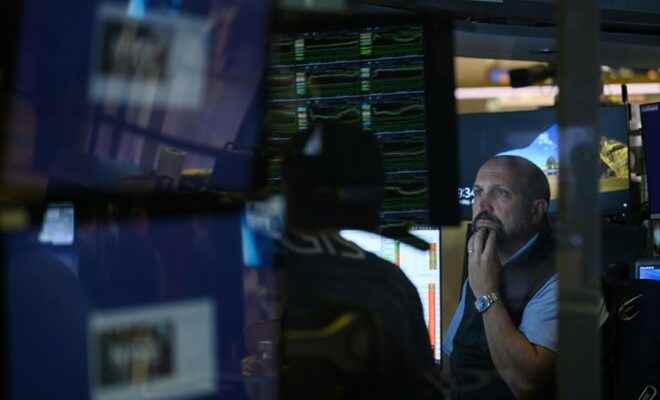An operator of the New York Stock Exchange (AFP/ANGELA WEISS)
The New York Stock Exchange ended sharply lower Friday after a second straight session sawtooth, depressed by the slowdown of American consumers, concerned about inflation.
The Dow Jones lost 1.34%, the Nasdaq index dropped 3.08% and the broader S&P 500 index fell 2.37%.
After a rollercoaster day on Thursday, the New York market had continued its technical rebound from the previous day at the start of the session.
But the momentum was quickly snuffed out by several macroeconomic indicators, including retail sales, which were stable in September when economists were hoping for a 0.2% increase over one month.
“High inflation and rising interest rates have forced consumers to be more discerning in their purchases,” said Oren Klachkin of Oxford Economics.
But investors mostly noted data from the University of Michigan consumer confidence survey.
While the general index came in above expectations in October, at 59.8 points against 58.6 in September, American consumers now see inflation at 5.1% over a one-year horizon, against 4.6% in September.
On average, respondents expect inflation to be 2.9% in the next 5 to 10 years, compared to 2.7% in September.
“THE thing the Fed (US central bank) does not want to see is rising inflation expectations,” said Quincy Krosby of LPL Financial. However, “they have evolved in the wrong direction.”
The acceleration of inflation expectations is a phenomenon feared by central bankers because it is likely to create an inflationary spiral that prolongs the rise in prices over time, or even aggravates it.
Therefore, “it is expected that the Fed will continue its aggressive campaign” of raising interest rates, and that the path to price stabilization will be difficult for the markets”, according to Quincy Krosby.
Operators continue to recalibrate their monetary policy expectations and now see the Fed’s key rate at nearly 5% next April.
Bond rates firmed up on Friday, with the prospect of monetary tightening even more marked than expected. The yield on 10-year US government bonds stood at 4.02%, against 3.94% the day before.
For Art Hogan, of B. Riley Wealth Management, this rise in bond rates has contributed to cooling equity markets.
For Maris Ogg, of Tower Bridge Advisors, investors will be particularly attentive, in addition to macroeconomic data, to company forecasts during the earnings season which has just begun.
If they are cautious “and the shares do not move or rise, it will show that we are not far from the end of the bear market” (bear market), according to the analyst.
No less than four major US banks released their quarterly results on Friday before market.
The results of JPMorgan Chase (+1.66% to 111.19 dollars), above expectations whether for turnover or net profit, were welcomed. CEO Jamie Dimon nevertheless warned: “There are significant headwinds directly in front of us”, be it inflation, the ongoing monetary tightening or the war in Ukraine.
Its rival Citigroup (+0.65% to 43.23 dollars), like JPMorgan Chase, took advantage of the dynamism of retail banking to offset the deceleration of investment banking activities, handicapped by a tightening of credit conditions and uncertainty about the trajectory of the economy.
Both its turnover and its net profit were down, but above expectations.
Another banking establishment to publish its results on Friday, Wells Fargo (+1.86% to 43.17 dollars) did better than expected on its turnover, partly due to the rise in interest rates, which allows it to restore its margins.
As for Morgan Stanley (-5.07% to 75.30 dollars), which does not have a retail bank, it suffered from the bad climate for market activities and published a turnover quite significantly below forecasts analysts.
The Albertsons supermarket chain fell (-8.45% to 26.21 dollars) after the announcement of its takeover by its competitor Kroger, for 24.6 billion dollars, debt included.
The price of the title was almost aligned with the price proposed by Kroger, ie 34.10 dollars, from which will be deducted an exceptional dividend of 6.85 dollars, which brings the amount actually offered per share to 27.25 dollars.
The marriage will give birth to a juggernaut of mass distribution, with nearly 5,000 stores and 710,000 employees.
© 2022 AFP
Did you like this article ? Share it with your friends with the buttons below.




